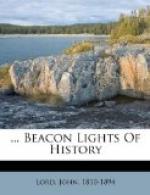Galileo had been destined by his father to the profession of medicine, and was ignorant of mathematics. He amused his leisure hours with painting and music, and in order to study the principles of drawing he found it necessary to acquire some knowledge of geometry, much to the annoyance of his father, who did not like to see his mind diverted from the prescriptions of Hippocrates and Galen. The certain truths of geometry burst upon him like a revelation, and after mastering Euclid he turned to Archimedes with equal enthusiasm. Mathematics now absorbed his mind, and the father was obliged to yield to the bent of his genius, which seemed to disdain the regular professions by which social position was most surely effected. He wrote about this time an essay on the Hydrostatic Balance, which introduced him to Guido Ubaldo, a famous mathematician, who induced him to investigate the subject of the centre of gravity in solid bodies. His treatise on this subject secured an introduction to the Grand Duke of Tuscany, who perceived his merits, and by whom he was appointed a lecturer on mathematics at Pisa, but on the small salary of sixty crowns a year.
This was in 1589, when he was twenty-five, an enthusiastic young man, full of hope and animal spirits, the charm of every circle for his intelligence, vivacity, and wit; but bold and sarcastic, contemptuous of ancient dogmas, defiant of authority, and therefore no favorite with Jesuit priests and Dominican professors. It is said that he was a handsome man, with bright golden locks, such as painters in that age loved to perpetuate upon the canvas; hilarious and cheerful, fond of good cheer, yet a close student, obnoxious only to learned dunces and narrow pedants and treadmill professors and zealous priests,—all of whom sought to molest him, yet to whom he was either indifferent or sarcastic, holding them and their formulas up to ridicule. He now directed his inquiries to the mechanical doctrines of Aristotle, to whose authority the schools had long bowed down, and whom he too regarded as one of the great intellectual giants of the world, yet not to be credited without sufficient reasons. Before the “Novum Organum” was written, he sought, as Bacon himself pointed out, the way to arrive at truth,— a foundation to stand upon, a principle tested by experience, which, when established by experiment, would serve for sure deductions.
Now one of the principles assumed by Aristotle, and which had never been disputed, was, that if different weights of the same material were let fall from the same height, the heavier would reach the ground sooner than the lighter, and in proportion to the difference of weight. This assumption Galileo denied, and asserted that, with the exception of a small difference owing to the resistance of the air, both would fall to the ground in the same space of time. To prove his position by actual experiment, he repaired to the leaning tower of Pisa, and demonstrated that




